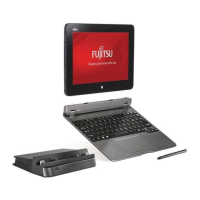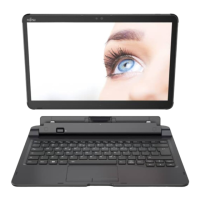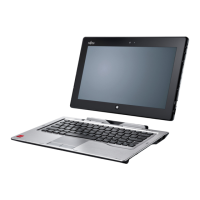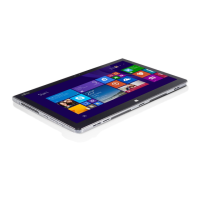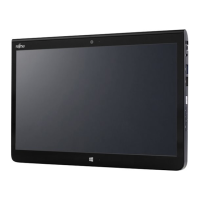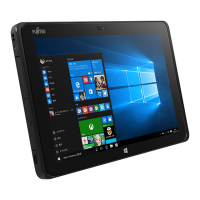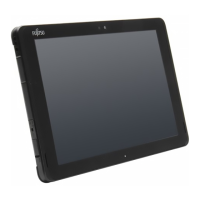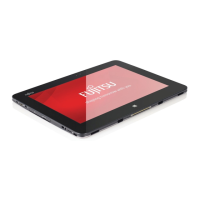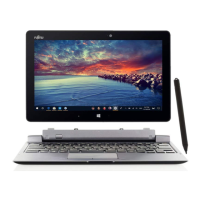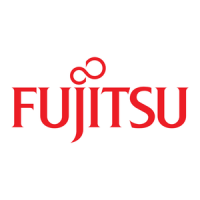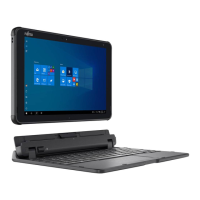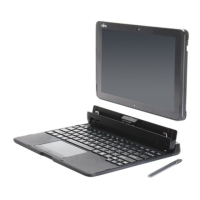Do you have a question about the Fujitsu STYLISTIC Q738 and is the answer not in the manual?
Explains symbols and styles used in the manual for clarity and emphasis.
Safety precautions for using wireless features like Wi-Fi and Bluetooth.
Instructions and tips for safely traveling with the device.
Guidelines for protecting the device during transport.
Guidance on selecting a suitable and safe place for device setup.
Steps for connecting the AC adapter for initial power.
Instructions for powering on the device for the initial setup.
Guide to installing additional software applications.
Explanation of the device's status lights for power, charging, and wireless.
Procedure for turning the tablet PC on using the power button.
Information on customizing the function of the ON/OFF button.
Correct procedure for shutting down the tablet PC.
Details on using the handwriting recognition feature and supported languages.
Information on the touchscreen display quality and resolution.
Instructions on executing commands using finger input on the touchscreen.
Guide to calibrating the touchscreen for accurate finger input.
Instructions on using the stylus for navigation and input.
Description of the tablet's physical buttons and their functions.
Information on the device's built-in webcams and their usage.
Details on the built-in battery, its life, and care.
Information on supported memory card formats and usage.
Details about the SIM card slot and supported format.
Information on wireless components and their capabilities.
Instructions for connecting to a local area network via Ethernet.
Information on the device's GPS functionality.
Steps to adjust stylus settings for optimal performance.
Procedure for calibrating the stylus for accurate input.
Guide to attaching the optional stylus tether for security.
Procedure for safely removing the SIM card from the device.
Information on connecting to the internet using UMTS.
Details on using Wireless WAN for connectivity.
Information on connecting to the internet using 4G.
Explanation of Near Field Communication capabilities.
Description of the optional docking cradle for charging and connectivity.
Information about the optional keyboard docking station.
Details on the optional VESA mount plate for mounting the device.
Instructions for attaching the optional hand strap.
Information on the optional folio case for protecting the tablet.
Guide to installing the protective TPU cover with hand strap.
Identifies the parts included with the docking cradle.
Steps for properly setting up the docking cradle.
Procedure for docking the tablet PC into the cradle.
Procedure for safely removing the tablet PC from the cradle.
Details the ports available on the keyboard docking station.
General notes related to the keyboard docking station.
Procedure for connecting the tablet PC to the keyboard docking station.
Procedure for safely removing the tablet PC from the keyboard docking station.
Steps to install the tablet PC into the protective TPU cover.
Guide to setting up and using the fingerprint sensor for security.
Information on the palm vein sensor feature and its setup.
Instructions for using the security lock to prevent theft.
Steps to enhance data security by setting BIOS passwords.
How to set up password protection for system startup.
Procedure to enable password protection for the hard disk drives.
Information about the optional SmartCard reader and its capabilities.
Details on the Trusted Platform Module and its security functions.
Setting up supervisor and user passwords for BIOS access.
Procedure for removing existing BIOS passwords.
Steps for inserting a SmartCard into the reader.
Procedure to enable the Trusted Platform Module in BIOS.
Procedure to disable the Trusted Platform Module in BIOS.
Guide to connecting external monitors via HDMI and VGA.
Instructions for connecting external devices via USB ports.
How to connect headphones, microphones, and speakers.
Details on using the Micro HDMI port for external display.
Information on connecting external monitors via the VGA port.
Procedure for safely disconnecting USB devices to prevent data loss.
Guide to connecting headphones and speakers to the device.
Instructions for connecting microphones and audio input devices.
Procedure to access and start the BIOS Setup Utility.
Explanation of how to navigate and use the BIOS Setup Utility.
Options for saving or discarding changes and exiting the BIOS Utility.
Methods for resetting the device when it is unresponsive.
Guidance on what to do when encountering unresolved problems.
Instructions for restoring the system to its original state.
Troubleshooting steps for incorrect date or time settings.
Solutions for when the battery charging indicator is not illuminated.
Troubleshooting steps when the touchscreen display is dark.
Tips for improving touchscreen readability.
Solutions for issues where the external monitor displays nothing.
Troubleshooting steps for stylus input inaccuracies.
Steps to resolve issues where the device fails to start.
Troubleshooting steps for printer connectivity and driver issues.
Solutions for problems with wireless network connectivity.
Tips for improving battery life and troubleshooting fast discharge.
Troubleshooting steps when the Smart Card reader is not detected.
Explanation of acoustic warnings, like low battery.
Information on interpreting and resolving error messages.
Procedure for performing a forced shutdown of the device.
Steps to reset the rechargeable battery.
Troubleshooting for blank or unstable external monitor output.
Troubleshooting steps when stylus input is not functional.
Troubleshooting steps when the tablet PC unexpectedly stops functioning.
Steps to take if the Smart Card PIN is forgotten.
Procedures for lost user or supervisor Smart Cards.
Troubleshooting steps when the Smart Card is lost.
Technical specifications for the Tablet PC hardware and components.
Information on proper disposal and recycling of the device and its parts.
Regulatory notices from Industry Canada.
Safety instructions and precautions related to UL certification.
Information on the device's compliance with ENERGY STAR standards.
Guidelines for recycling the device's rechargeable battery.
General regulatory notes and statements for the device.
Disclaimers and important regulatory information.
Information regarding FCC radio frequency exposure limits and compliance.
Information on wireless LAN, health effects, and usage authorization.
Statements from FCC and Industry Canada regarding device compliance.
Details on FCC requirements for interference.
French statement on FCC/Industry Canada RF exposure.
Information on export restrictions for the product.
French text detailing export restrictions.
Important notices for Canadian users regarding wireless devices.
French notices for Canadian users regarding wireless devices.
Setup and configuration guide for the optional wireless LAN device.
Explanation of different wireless LAN modes like Ad Hoc and Infrastructure.
Instructions for turning off or disconnecting the WLAN device.
Common WLAN problems and their solutions.
Lists the specific WLAN devices this document applies to.
Details the features and capabilities of the WLAN device.
Explains the Infrastructure mode for wireless network connectivity.
Guide to configuring wireless LAN settings in Windows.
Steps for connecting to an active wireless network.
Procedures for Windows 10 image backup and system recovery.
Step-by-step guide to creating a USB recovery drive.
Overview of recovery options available in Windows 10.
Procedure for restoring the system to a previous restore point.
Steps to reset the PC, either keeping or removing files.
Guide to reinstalling Windows using a recovery drive.
Instructions for reinstalling Windows using installation media.
Explains symbols and styles used in the manual for clarity and emphasis.
Safety precautions for using wireless features like Wi-Fi and Bluetooth.
Instructions and tips for safely traveling with the device.
Guidelines for protecting the device during transport.
Guidance on selecting a suitable and safe place for device setup.
Steps for connecting the AC adapter for initial power.
Instructions for powering on the device for the initial setup.
Guide to installing additional software applications.
Explanation of the device's status lights for power, charging, and wireless.
Procedure for turning the tablet PC on using the power button.
Information on customizing the function of the ON/OFF button.
Correct procedure for shutting down the tablet PC.
Details on using the handwriting recognition feature and supported languages.
Information on the touchscreen display quality and resolution.
Instructions on executing commands using finger input on the touchscreen.
Guide to calibrating the touchscreen for accurate finger input.
Instructions on using the stylus for navigation and input.
Description of the tablet's physical buttons and their functions.
Information on the device's built-in webcams and their usage.
Details on the built-in battery, its life, and care.
Information on supported memory card formats and usage.
Details about the SIM card slot and supported format.
Information on wireless components and their capabilities.
Instructions for connecting to a local area network via Ethernet.
Information on the device's GPS functionality.
Steps to adjust stylus settings for optimal performance.
Procedure for calibrating the stylus for accurate input.
Guide to attaching the optional stylus tether for security.
Procedure for safely removing the SIM card from the device.
Information on connecting to the internet using UMTS.
Details on using Wireless WAN for connectivity.
Information on connecting to the internet using 4G.
Explanation of Near Field Communication capabilities.
Description of the optional docking cradle for charging and connectivity.
Information about the optional keyboard docking station.
Details on the optional VESA mount plate for mounting the device.
Instructions for attaching the optional hand strap.
Information on the optional folio case for protecting the tablet.
Guide to installing the protective TPU cover with hand strap.
Identifies the parts included with the docking cradle.
Steps for properly setting up the docking cradle.
Procedure for docking the tablet PC into the cradle.
Procedure for safely removing the tablet PC from the cradle.
Details the ports available on the keyboard docking station.
General notes related to the keyboard docking station.
Procedure for connecting the tablet PC to the keyboard docking station.
Procedure for safely removing the tablet PC from the keyboard docking station.
Steps to install the tablet PC into the protective TPU cover.
Guide to setting up and using the fingerprint sensor for security.
Information on the palm vein sensor feature and its setup.
Instructions for using the security lock to prevent theft.
Steps to enhance data security by setting BIOS passwords.
How to set up password protection for system startup.
Procedure to enable password protection for the hard disk drives.
Information about the optional SmartCard reader and its capabilities.
Details on the Trusted Platform Module and its security functions.
Setting up supervisor and user passwords for BIOS access.
Procedure for removing existing BIOS passwords.
Steps for inserting a SmartCard into the reader.
Procedure to enable the Trusted Platform Module in BIOS.
Procedure to disable the Trusted Platform Module in BIOS.
Guide to connecting external monitors via HDMI and VGA.
Instructions for connecting external devices via USB ports.
How to connect headphones, microphones, and speakers.
Details on using the Micro HDMI port for external display.
Information on connecting external monitors via the VGA port.
Procedure for safely disconnecting USB devices to prevent data loss.
Guide to connecting headphones and speakers to the device.
Instructions for connecting microphones and audio input devices.
Procedure to access and start the BIOS Setup Utility.
Explanation of how to navigate and use the BIOS Setup Utility.
Options for saving or discarding changes and exiting the BIOS Utility.
Methods for resetting the device when it is unresponsive.
Guidance on what to do when encountering unresolved problems.
Instructions for restoring the system to its original state.
Troubleshooting steps for incorrect date or time settings.
Solutions for when the battery charging indicator is not illuminated.
Troubleshooting steps when the touchscreen display is dark.
Tips for improving touchscreen readability.
Solutions for issues where the external monitor displays nothing.
Troubleshooting steps for stylus input inaccuracies.
Steps to resolve issues where the device fails to start.
Troubleshooting steps for printer connectivity and driver issues.
Solutions for problems with wireless network connectivity.
Tips for improving battery life and troubleshooting fast discharge.
Troubleshooting steps when the Smart Card reader is not detected.
Explanation of acoustic warnings, like low battery.
Information on interpreting and resolving error messages.
Procedure for performing a forced shutdown of the device.
Steps to reset the rechargeable battery.
Troubleshooting for blank or unstable external monitor output.
Troubleshooting steps when stylus input is not functional.
Troubleshooting steps when the tablet PC unexpectedly stops functioning.
Steps to take if the Smart Card PIN is forgotten.
Procedures for lost user or supervisor Smart Cards.
Troubleshooting steps when the Smart Card is lost.
Technical specifications for the Tablet PC hardware and components.
Information on proper disposal and recycling of the device and its parts.
Regulatory notices from Industry Canada.
Safety instructions and precautions related to UL certification.
Information on the device's compliance with ENERGY STAR standards.
Guidelines for recycling the device's rechargeable battery.
General regulatory notes and statements for the device.
Disclaimers and important regulatory information.
Information regarding FCC radio frequency exposure limits and compliance.
Information on wireless LAN, health effects, and usage authorization.
Statements from FCC and Industry Canada regarding device compliance.
Details on FCC requirements for interference.
French statement on FCC/Industry Canada RF exposure.
Information on export restrictions for the product.
French text detailing export restrictions.
Important notices for Canadian users regarding wireless devices.
French notices for Canadian users regarding wireless devices.
Setup and configuration guide for the optional wireless LAN device.
Explanation of different wireless LAN modes like Ad Hoc and Infrastructure.
Instructions for turning off or disconnecting the WLAN device.
Common WLAN problems and their solutions.
Lists the specific WLAN devices this document applies to.
Details the features and capabilities of the WLAN device.
Explains the Infrastructure mode for wireless network connectivity.
Guide to configuring wireless LAN settings in Windows.
Steps for connecting to an active wireless network.
Procedures for Windows 10 image backup and system recovery.
Step-by-step guide to creating a USB recovery drive.
Overview of recovery options available in Windows 10.
Procedure for restoring the system to a previous restore point.
Steps to reset the PC, either keeping or removing files.
Guide to reinstalling Windows using a recovery drive.
Instructions for reinstalling Windows using installation media.
| Operating System | Windows 10 Pro |
|---|---|
| RAM | 8 GB or 16 GB |
| Storage | 256 GB or 512 GB SSD |
| Battery Life | Up to 10 hours |
| Ports | 1 x USB 3.0, 1 x HDMI, 1 x MicroSD card slot, 1 x 3.5mm headphone jack |
| Wireless | Wi-Fi 802.11ac, Bluetooth |
| Security | Fingerprint sensor, TPM 2.0 |
| Processor | Intel Core i5 or i7 |
| Display Size | 13.3 inch |
| Display Resolution | 1920 x 1200 pixels |
